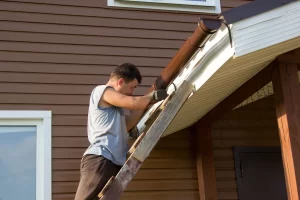Understanding the Basics: What Are Rain Gutters and How Do They Work?
Rain gutters are an essential part of any home’s exterior, playing a crucial role in directing rainwater away from the structure. While they may not always be the first thing homeowners think about, they are vital in protecting a house from water damage. Understanding what rain gutters are, how they work, and why they are necessary can help homeowners maintain their property more effectively.
The Purpose of Rain Gutters
Rain gutters are designed to collect and channel rainwater that runs off the roof. Without them, water would flow freely down the sides of a building, leading to issues such as soil erosion, foundation damage, and basement flooding. By directing water to a designated drainage area, gutters help preserve the structural integrity of a home and prevent costly repairs.
Components of a Gutter System
 A rain gutter system consists of several key components that work together to manage water flow efficiently. The horizontal channels attached to the edge of the roof collect rainwater and direct it toward vertical downspouts. These downspouts then carry the water to the ground or a drainage system, ensuring that it does not accumulate around the foundation. Additionally, accessories like gutter guards, end caps, and splash blocks enhance the effectiveness of the system by preventing debris buildup and controlling the flow of water.
A rain gutter system consists of several key components that work together to manage water flow efficiently. The horizontal channels attached to the edge of the roof collect rainwater and direct it toward vertical downspouts. These downspouts then carry the water to the ground or a drainage system, ensuring that it does not accumulate around the foundation. Additionally, accessories like gutter guards, end caps, and splash blocks enhance the effectiveness of the system by preventing debris buildup and controlling the flow of water.
How Rain Gutters Work
When it rains, water collects on the roof and begins to flow toward the edges. The gutters catch this water and guide it toward the downspouts, which then transport it safely away from the home. The angle or slope of the gutters ensures that water moves efficiently, preventing standing water that could lead to overflow or leaks. By effectively managing rainwater, gutters help prevent damage to siding, windows, and landscaping.
Types of Rain Gutters
Rain gutters come in a variety of materials and designs, each offering unique benefits. Aluminum gutters are lightweight, resistant to rust, and easy to install, making them a popular choice for homeowners. Vinyl gutters are another cost-effective option, known for their durability and low maintenance requirements. For those looking for a more long-lasting solution, copper and steel gutters provide enhanced strength and aesthetic appeal. Additionally, gutters are available in different shapes, including K-style and half-round designs, which impact their efficiency and appearance.
The Importance of Proper Gutter Maintenance
Regular maintenance is essential to keep gutters functioning properly. Leaves, twigs, and other debris can accumulate in the channels, leading to clogs that prevent water from flowing freely. When gutters become blocked, they may overflow, causing water to spill onto the walls and foundation of the home. Cleaning gutters periodically and installing gutter guards can help reduce the risk of clogging and ensure that rainwater is properly directed away from the structure.
Common Gutter Problems and Their Solutions
Several issues can affect the performance of a gutter system over time. Sagging gutters, often caused by loose fasteners or excess debris, can lead to improper drainage. Leaks can develop at seams or joints, allowing water to escape before reaching the downspout. Ice dams in colder climates can create blockages and contribute to roof damage. Addressing these problems early by reinforcing fasteners, sealing leaks, and ensuring proper insulation can help extend the lifespan of the gutter system and prevent costly repairs.
Why Gutters Are Essential for Home Protection
Without a functional gutter system, rainwater can cause significant damage to a home. Water pooling around the foundation can lead to cracks and structural instability. Excess moisture can also contribute to mold growth, which can affect indoor air quality. By efficiently directing rainwater away from the home, gutters provide protection against these potential hazards, making them a necessary investment for homeowners.
Choosing the Right Gutters for Your Home
Selecting the right gutter system depends on various factors, including climate, budget, and home design. Homes in areas with heavy rainfall may require larger gutters to handle increased water flow. Seamless gutters, which are custom-fitted to the home, offer a more leak-resistant option compared to traditional sectional gutters. Consulting with a professional can help homeowners determine the best gutter type and installation method for their specific needs.